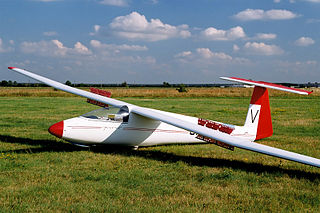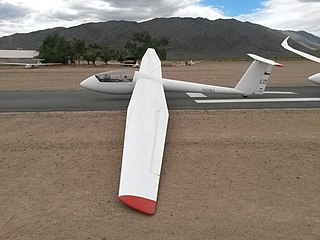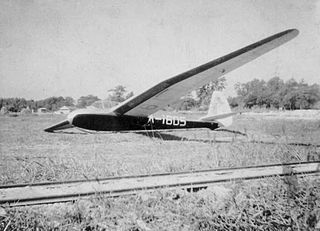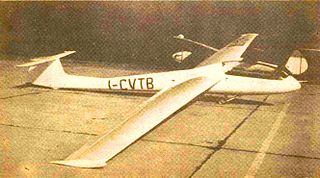
The SZD-30 Pirat is a single-seat multi-purpose glider aircraft from the Polish firm PZL Bielsko, which first flew in 1966 and was produced beginning in 1967.

The SZD-45 Ogar (Hound) is a T-tailed cantilever high-wing monoplane of wooden, aluminium and fibreglass construction designed and manufactured in Poland.

The Let L-33 Solo is a Czech shoulder-wing, single-seat, glider, designed by Marian Meciar and Vaclav Zajic, and produced by Let Kunovice. The L-33 first flew in 1992 and remained in production through 2012, supplied as a ready-to-fly aircraft.

The Scheibe SF 34 Delphin is a two-seat sailplane that was produced by Scheibe in Germany in the late 1970s and 1980s. Designed by Wolf Hoffmann and originally designated the SF H34, it was Scheibe's first unpowered aircraft of composite construction.

The Scheibe SF-27 Zugvogel V is a single seat Standard Class sailplane, designed and built in Germany in the 1960s. A motorised version was also produced. Significant numbers remain active.
The Moore SS-1 is an American high-wing, single seat, FAI Standard Class glider that was designed and constructed by Arien C. Moore of Sweet Home, Oregon.
The Akaflieg Darmstadt D-28 Windspiel was a single-seat, high-performance sailplane designed in Germany in the early 1930s. Intended to exploit a growing understanding of thermal soaring, it was small and manoeuvrable, with a 12 m span; silk-covered for lightness, it weighed less (empty) than its pilots. It held the world straight-line distance record for a time in 1934.
The Akaflieg Braunschweig SB-7 Nimbus is a Standard class glider designed and built in Germany in the 1960s. It was one of a series of mixed glass fibre and wood designs from the students of Akaflieg Braunschweig.
The Horikawa H-23B-2 is a two-seat training glider designed and built in Japan in the 1950s. It was produced in small numbers.
The Kometa-Standard was a Standard Class glider, designed and built in Bulgaria in the early 1960s. Thirty were flown by local gliding clubs.

The Maeda 703 was one of the first indigenous Japanese gliders, a high performance single seat aircraft which first flew in 1940. Three were built, two with gull wing wings; one of these set a national endurance record in 1941.
The Aérostructure Lutin 80, earlier known as the PLM 80, is a small, single seat motor glider with a low power pusher configuration engine, designed and built in France in the 1980s. Only two were completed.
The Farner HF Colibri 1 SL was an unusual canard motor glider with a unique control system, designed and built in Switzerland in the late 1970s. Only one was constructed; much modified during the 1980s, it was still flying in 1990.
The Aviomilano CPV1, also known as the Arlecchino, was an Italian high performance sailplane built in the early 1960s. Only one was built.

The CVT2 Veltro was an Italian competition glider built in the mid-1950s. Its advanced design incorporated a laminar flow wing, T-tail, retracting undercarriage and a reclining seat to reduce parasitic drag.
The Teichfuss Astore was an Italian Intermediate single-seat trainer glider designed by Luigi Teichfuss and flown in 1936. Two were built.
The Scheibe SF-30 Club-Spatz is a 15 m class single seat sailplane built in Germany in the 1970s and intended for club use.
The IIL IS-5 was a single seat, high performance sailplane designed by Iosif Șilimon and built in Romania in 1960.
The IIL IS-10 was a high-performance, single-seat glider, designed and built in Romania in the early 1960s. It was the first Romanian aircraft to use laminar flow airfoils.
The Aerobul HB-1 Club was a Club class training sailplane built in Argentina in 1988.







